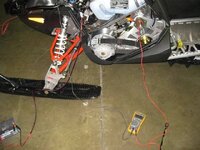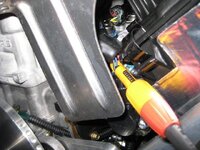Hey Guys,
Thought some of you might like this info.
A little background. The Throttle Position Sensor or TPS is a vital part of making sure your motor is getting the right amount of fuel and timing at exactly the right time. The factory tunes the engine to a specific setting and this being out of adjustment can cause your sled to behave in many different ways, ie:slower than your buddies, hard to tune, misses, stumbles. We believe strongly in everyone checking there TPS with a multimeter if you want to be sure that your machine is running at peak performance.
We just checked the tps setting on a brand new 2012 Pro 800 and found the tps to be at .703 base setting and idle was set at .925vdc. We contacted factory dealer tech and was told that they are no longer giving a base spec, you must use the digital wrench to set base spec. We have contacted a few of the polaris dealers we work with and was given a base spec of .70. The factory idle spec is .93-.95vdc. I believe we understand why the adjustment was off. The tightening of the screws actually slightly changes the setting. So...We can only assume that Polaris is setting the tps, removing whatever they are checking it with and tightening it down. We tightened the screws while leaving the multimeter hooked up to make sure the setting stayed within range. This sled ran flawless but we wanted to check just to make sure we are getting everything out of it that we can.
We adjusted the base setting to .70 and the idle setting at .940. The sled now starts on first pull when it is cold. It used to take three prior to adjustment. Coincidence? I doubt it.
We used the ECU power up kit from slp and a fluke multimeter to check ours.
Going through the TPS calibration process is important on a stock sled and extra, extra important when running a power commander. Hope this helps.
Thanks to all of you who helped set us straight on this.


Thought some of you might like this info.
A little background. The Throttle Position Sensor or TPS is a vital part of making sure your motor is getting the right amount of fuel and timing at exactly the right time. The factory tunes the engine to a specific setting and this being out of adjustment can cause your sled to behave in many different ways, ie:slower than your buddies, hard to tune, misses, stumbles. We believe strongly in everyone checking there TPS with a multimeter if you want to be sure that your machine is running at peak performance.
We just checked the tps setting on a brand new 2012 Pro 800 and found the tps to be at .703 base setting and idle was set at .925vdc. We contacted factory dealer tech and was told that they are no longer giving a base spec, you must use the digital wrench to set base spec. We have contacted a few of the polaris dealers we work with and was given a base spec of .70. The factory idle spec is .93-.95vdc. I believe we understand why the adjustment was off. The tightening of the screws actually slightly changes the setting. So...We can only assume that Polaris is setting the tps, removing whatever they are checking it with and tightening it down. We tightened the screws while leaving the multimeter hooked up to make sure the setting stayed within range. This sled ran flawless but we wanted to check just to make sure we are getting everything out of it that we can.
We adjusted the base setting to .70 and the idle setting at .940. The sled now starts on first pull when it is cold. It used to take three prior to adjustment. Coincidence? I doubt it.
We used the ECU power up kit from slp and a fluke multimeter to check ours.
Going through the TPS calibration process is important on a stock sled and extra, extra important when running a power commander. Hope this helps.
Thanks to all of you who helped set us straight on this.


Last edited:


